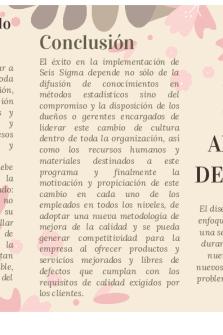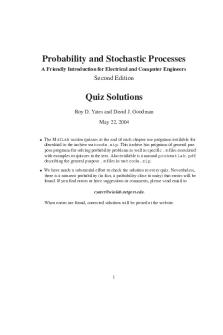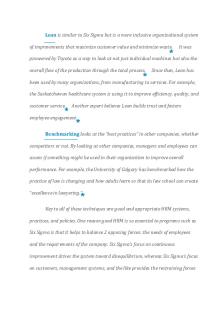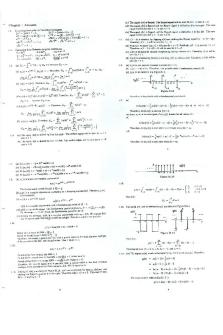An Introduction to Six Sigma and Process Improvement 2nd edition by Evans Lindsay Solution Manual PDF

| Title | An Introduction to Six Sigma and Process Improvement 2nd edition by Evans Lindsay Solution Manual |
|---|---|
| Author | Pham Quang Huy |
| Course | Electronics |
| Institution | Đại học Hà Nội |
| Pages | 28 |
| File Size | 420.7 KB |
| File Type | |
| Total Downloads | 105 |
| Total Views | 161 |
Summary
Download An Introduction to Six Sigma and Process Improvement 2nd edition by Evans Lindsay Solution Manual PDF
Description
An Introduction to Six Sigma and Process Improvement 2nd edition by James R. Evans, William M. Lindsay Solution Manual Link full download solution manual: https://findtestbanks.com/download/an-introduction-to-six-sigma-andprocess-improvement-2nd-edition-by-evans-lindsay-solution-manual/
CHAPTER 2
Principles of Six Sigma Teaching Notes This chapter brings the Six Sigma principles and concepts into a sharp focus, and builds on the need to integrate a performance management framework with operational requirements in managing quality. In this chapter, we introduce the statistical basis for Six Sigma, and outline the requirements for Six Sigma implementation. Key objectives for this chapter should be to assist students:
To define the Six Sigma Body of Knowledge and show how it is being used as an integrating framework for this textbook.
To appreciate that there is a need for organizations to align Six Sigma projects with an organization’s strategy, and address any perceived weaknesses or threats that may have been identified during the strategic planning process.
To understand that a problem is defined as: a deviation between what should be happening and what actually is happening that is important enough to make someone think the deviation ought to be corrected.
To learn to classify quality problems into one of five categories, including: a) conformance problems, b) efficiency problems, c) unstructured performance problems, d) product design problems, and e) process design problems.
To learn that Six Sigma can be applied to a wide variety of transactional, administrative, and service areas in addition to manufacturing. However, differences between services and manufacturing make opportunities in services more difficult to identify, and projects more difficult to define. Small organizations can use Six Sigma, although perhaps in a more informal fashion.
1
Chapter 2 – Process Concepts and Systems Thinking
2
To apply Six Sigma processes and concepts to service processes to enhance one of four key measures of performance: • Accuracy, as measured by correct financial figures, completeness of information, or freedom from data errors • Cycle time, which is a measure of how long it takes to do something, such as pay an invoice • Cost, that is, the internal cost of process activities (in many cases, cost is largely determined by the accuracy and/or cycle time of the process; the longer it takes, and the more mistakes that have to be fixed, the higher the cost) Customer satisfaction, which is typically the primary measure of success •
To reinforce the definition of a process as ―a fundamental way of viewing work in an organization‖ (from Chapter 1) and to develop the concept of a set of processes, which together, form a system – an integrated set of activities within an organization that work together for the aim of the organization.
To develop the classifications of processes as: 1. Value-creation processes (sometimes called core processes), which are most important to ―running the business‖ and maintaining or achieving a sustainable competitive advantage, and 2. Support processes, which those that contribute to the successful performance of an organization’s value-creation processes, employees, and daily operations.
To understand the definitions and importance of variation in Six Sigma processes, including: factors which are present as a natural part of a process and are referred to as common causes of variation. Common causes are a result of the design of the product and production system and generally account for about 80 to 95 percent of the observed variation in the output of a production process. AND The remaining variation in a production process is the result of special causes, often called assignable causes of variation. Special causes arise from external sources that are not inherent in the process. They appear sporadically and disrupt the random pattern of common causes.
To learn that in Six Sigma terminology, a nonconformance is any defect or error that is passed on to the customer. In manufacturing we often use the term defect, and in service applications, we generally use the term error to describe a nonconformance.
A nonconforming unit of work is one that has one or more defects or errors. For discrete data, the two important metrics are the proportion nonconforming and nonconformances per unit (NPU).
A common measure of output quality is defects per unit (DPU), computed as Number of defects discovered/Number of units produced, and in Six Sigma metrics, defects per
Chapter 2 – Process Concepts and Systems Thinking
3
million opportunities (dpmo) = DPU 1000000/opportunities for error. A six-sigma quality level corresponds to at most 3.4 dpmo.
To learn that quality in processes has a cumulative impact, where the quality output at each stage in the process must be considered. If a process consists of many steps, each step may create nonconformances, thus reducing the yield of the final output. One measure that is often used to evaluate the quality of the entire process is rolled throughput yield (RTY). RTY is the proportion of conforming units that results from a series of process steps. Mathematically, it is the product of the yields from each process step.
To appreciate that a structured problem solving process provides employees and teams with a common language and a set of tools to communicate with each other. The Six Sigma DMAIC methodology process provides this type of roadmap for conducting a Six Sigma project.
To develop understanding of the Six Sigma stages of: 1) Define - the process of drilling down to a more specific problem statement is sometimes called project scoping; 2) Measure - collecting good data, observation, and careful listening; 3) Analyze - focuses on why defects, errors, or excessive variation occur, and focuses on the root cause; 4) Improve - focuses on idea generation, evaluation, and selection; 5) Control - focuses on how to maintain the improvements.
To learn about Lean Six Sigma, defined as an integrated improvement approach to improve goods and services and operations efficiency by reducing defects, variation, and waste; and to apply classification of different types of muda (waste), and Kaizen events to lean Six Sigma projects.
To define lean tools and learn how they can be used to develop a lean organization.
To understand how Six Sigma and Lean complement one another and how they are converging.
ANSWERS TO REVIEW QUESTIONS 1. Briefly summarize the Six Sigma Body of Knowledge. Ans. Six Sigma encompasses a vast collection of concepts, tools, and techniques that are drawn from many areas of business, statistics, engineering, and practical experience. Many of these subjects are technical; others deal with management and organizational issues. Practitioners need a balanced set of both the ―hard‖ and the ―soft‖ disciplines in order to apply and implement Six Sigma effectively. (See list in the body of the chapter for more details.) 2. Describe the principal sources of ideas for Six Sigma projects.
Chapter 2 – Process Concepts and Systems Thinking
4
Ans. Ideas for Six Sigma projects stem from many sources. Often, they are driven by needs and opportunities to achieve an organization’s strategic goals, objectives, and action plans by which it seeks to create a competitive advantage. Six Sigma projects also stem from the fundamental need to improve results, captured in measures such as profit, market share, customer satisfaction, operational efficiency, product innovation, and quick response. 3. What are dashboards and balanced scorecards? How do they support Six Sigma projects? Ans. Dashboards typically consist of a small set of measures (five or six) that provide a quick summary of process performance. This term stems from the analogy to an automobile’s dashboard—a collection of indicators (speed, RPM, oil pressure, temperature, etc.) that summarize key performance measures. Dashboards often use graphs, charts, and other visual aids to communicate key measures and alert workers and managers when performance is not where it should be. The balanced scorecard is a summary of broad performance measures across the organization. The purpose of the balanced scorecard is ―to translate strategy into measures that uniquely communicate your vision to the organization.‖ A balanced scorecard defines the most important drivers of organizational success and consists of four perspectives:
Financial Perspective: Measures the ultimate results that the business provides to its shareholders. Internal Perspective: Focuses attention on the performance of the key internal processes that drive the business. Customer Perspective: Focuses on customer needs and satisfaction as well as market share. Innovation and Learning Perspective: Directs attention to the basis of a future success—the organization’s people and infrastructure..
Dashboards and scorecards provide rich sources of information for tracking progress. Results that are inferior to competitor’s performance, or which exhibit adverse trends often suggest the need for Six Sigma improvement projects. 4. List and briefly define the five categories of quality-related problem types. What are the best approaches for attacking each of these types of problems? Ans. Research using more than a thousand applicable published cases suggests that virtually every instance of quality-related problem-solving falls into one of five categories: 1. Conformance problems, which are characterized by unsatisfactory performance that causes customer dissatisfaction, such as high levels of defects, service failures, or customer complaints. The processes that create these results are typically well-specified and can be
Chapter 2 – Process Concepts and Systems Thinking
5
easily described. 2. Efficiency problems, which are characterized by unsatisfactory performance that causes dissatisfaction from the standpoint of noncustomer stakeholders, such as managers of financial or supply chain functions. Typical examples are high cost, excessive inventory, low productivity, and other process inefficiencies. 3. Unstructured performance problems, which are characterized by unsatisfactory performance by processes that are not well-specified or understood. For example, a company might discover that employee turnover is much higher than desired or employee satisfaction is low. The factors that contribute to such results do not stem from processes that can easily be described. 4. Product design problems, which involve designing new products or redesigning existing products to better satisfy customer needs. 5. Process design problems, which involve designing new processes or substantially revising existing processes. These might include new factory processes to manufacture a new product line or designing a more flexible assembly line. Each of these categories of problems requires different approaches and methodologies. Traditional Six Sigma methods are most applicable to conformance problems because the processes that create the problems can be easily identified, measured, analyzed, and changed. For efficiency problems, lean tools, which evolved from the Toyota producton system, are generally used. Unstructured performance problems require more creative approaches to solving them. For product and process design problems, special tools and methods or a combination of many of these approaches are used (and fall under the scope of DFSS – Design for Six Sigma). As Six Sigma has evolved, all of these tools and approaches have been consolidated into the Six Sigma body of knowledge, making it a powerful approach for any level of organizational problem solving. 5. Explain the application of Six Sigma in service organizations. How does it differ from manufacturing? How is it similar? Ans. Applying Six Sigma to services requires examination of four key measures of the performance: Accuracy, as measured by correct financial figures, completeness of information, or freedom from data errors Cycle time, which is a measure of how long it takes to do something, such as pay an invoice Cost, that is, the internal cost of process activities (in many cases, cost is largely determined by the accuracy and/or cycle time of the process; the longer it takes, and the more mistakes that have to be fixed, the higher the cost) Customer satisfaction, which is typically the primary measure of success While Six Sigma applies equally well in service areas as in manufacturing, it is true that services have some unique characteristics. First, the culture of a service firm is usually less scientific, and service employees typically do not think in terms of processes,
Chapter 2 – Process Concepts and Systems Thinking
6
measurements, and data. The processes are often invisible, complex, and not well defined or well documented. Also, the work typically requires considerable human intervention, such as customer interaction, underwriting or approval decisions, or manual report generation. These differences make opportunities difficult to identify, and projects difficult to define. Finally, similar service activities are often done in different ways. If you have three people doing the same job, perhaps in three different locations, it is unlikely that they will do the job in the same way. It should be noted that within the service sector, Six Sigma is beginning to be called transactional Six Sigma. 6. What are process owners and stakeholders? How are they different from each other? Ans. Individuals or groups, known as process owners, are accountable for process performance and have the authority to control and improve their process. Process owners may range from high-level executives who manage cross-functional processes to workers who run a manufacturing cell or an assembly operation on the shop floor. They are important members of Six Sigma project teams because of their understanding of and involvement in processes. Other individuals or groups, called stakeholders, are or might be affected by an organization’s actions and success; thus, they are vital to a Six Sigma project. Stakeholders might include customers, the workforce, partners, collaborators, governing boards, stockholders, donors, suppliers, taxpayers, regulatory bodies, policy makers, funders, and local and professional communities. 7. Define the two general categories of processes in any organization and provide examples of each. Ans. The two general categories of processes and examples are: 1.Value-creation processes (sometimes called core processes), which are most important to ―running the business‖ and maintaining or achieving a sustainable competitive advantage, and 2.Support processes, which those that contribute to the successful performance of an organization’s value-creation processes, employees, and daily operations. Value-creation processes drive the creation of products and services, are critical to customer satisfaction, and have a major impact on the strategic goals of an organization. They typically include design, production/delivery, and other critical business processes. Support processes provide infrastructure for value-creation processes but generally do not add value directly to the product or service. A process such as order entry that might be thought of as a value creation process for one company (e.g., a direct mail distributor) might be considered as a support process for another (e.g., a custom manufacturer). In general, value creation processes are driven by external customer needs while support processes are driven by internal customer needs. Because value creation processes do add value to products and services, they require a higher level of attention than do support processes.
Chapter 2 – Process Concepts and Systems Thinking
7
8. What are process requirements and how can they be identified? Ans. Understanding the requirements that processes should meet is vital to improving them. Given the diverse nature of value-creation processes, the requirements and performance characteristics might vary significantly for different processes. In general, value-creation process requirements are driven by consumer or external customer needs. For example, if hotel customers expect fast, error-free check-in, then the check-in process must be designed for speed and accuracy. Support process requirements, on the other hand, are driven by internal customer needs and must be aligned with the needs of key value creation processes. For example, information technology processes at a hotel must support the check-in process requirements of speed and accuracy; this would require real-time information on room availability. 9. Explain the concept of variation in processes. State the primary sources of process variation. Ans. Any process contains many sources of variation. In manufacturing, for example, different lots of material vary in strength, thickness, or moisture content. Cutting tools have inherent variation in their strength and composition. Even when measurements of several items by the same instrument are the same, it is due to a lack of precision in the measurement instrument; extremely precise instruments always reveal slight differences. Similar variation occurs in services, particularly as a result of inconsistency in human performance and the interface with technology. 10. Explain the difference between common and special cause of variation and provide some examples. Ans. The complex interactions of these variations in materials, tools, machines, operators, and the environment are not easily understood. Variation due to any of these individual sources appears at random; individual sources cannot be identified or explained. However their combined effect is stable and can usually be predicted statistically. These factors are present as a natural part of a process and are referred to as common causes of variation. Common causes are a result of the design of the product and production system and generally account for about 80 to 95 percent of the observed variation in the output of a production process. Therefore, common cause variation can only be reduced if the product is redesigned, or if better technology or training is provided for the production process. The remaining variation in a production process is the result of special causes, often called assignable causes of variation. Special causes arise from external sources that are not inherent in the process. They appear sporadically and disrupt the random pattern of common causes. Hence, they tend to be easily detectable using statistical methods, and usually economical to correct. Unusual variation that results from isolated incidents can be explained or corrected. A system governed only by common causes is called a stable
Chapter 2 – Process Concepts and Systems Thinking
8
system. Understanding a stable system and the differences between special and common causes of variation is essential for managing any system. 11. What operational problems are caused by excessive variation? Ans. Excessive variation can result in various ―evils,‖ including:
Variation increases unpredictability. If we don’t understand the variation in a system, we cannot predict its future performance. Variation reduces capacity utilization. If a process has little variability, then managers can increase the load on the process because they do not have to incorporate slack into their production plans. Variation contributes to a “bullwhip” effect. This well-known phenomenon occurs in supply chains; when small changes in demand occur, the variation in production and inventory levels...
Similar Free PDFs

SIX Sigma
- 4 Pages

Aplicacion SIX Sigma triptico
- 2 Pages

2nd edition quiz solution
- 83 Pages

Calidad total six Sigma
- 19 Pages

Six sigma HR
- 2 Pages

Metode Penelitian Six Sigma
- 1 Pages

SIx sigma el TPS
- 15 Pages
Popular Institutions
- Tinajero National High School - Annex
- Politeknik Caltex Riau
- Yokohama City University
- SGT University
- University of Al-Qadisiyah
- Divine Word College of Vigan
- Techniek College Rotterdam
- Universidade de Santiago
- Universiti Teknologi MARA Cawangan Johor Kampus Pasir Gudang
- Poltekkes Kemenkes Yogyakarta
- Baguio City National High School
- Colegio san marcos
- preparatoria uno
- Centro de Bachillerato Tecnológico Industrial y de Servicios No. 107
- Dalian Maritime University
- Quang Trung Secondary School
- Colegio Tecnológico en Informática
- Corporación Regional de Educación Superior
- Grupo CEDVA
- Dar Al Uloom University
- Centro de Estudios Preuniversitarios de la Universidad Nacional de Ingeniería
- 上智大学
- Aakash International School, Nuna Majara
- San Felipe Neri Catholic School
- Kang Chiao International School - New Taipei City
- Misamis Occidental National High School
- Institución Educativa Escuela Normal Juan Ladrilleros
- Kolehiyo ng Pantukan
- Batanes State College
- Instituto Continental
- Sekolah Menengah Kejuruan Kesehatan Kaltara (Tarakan)
- Colegio de La Inmaculada Concepcion - Cebu








